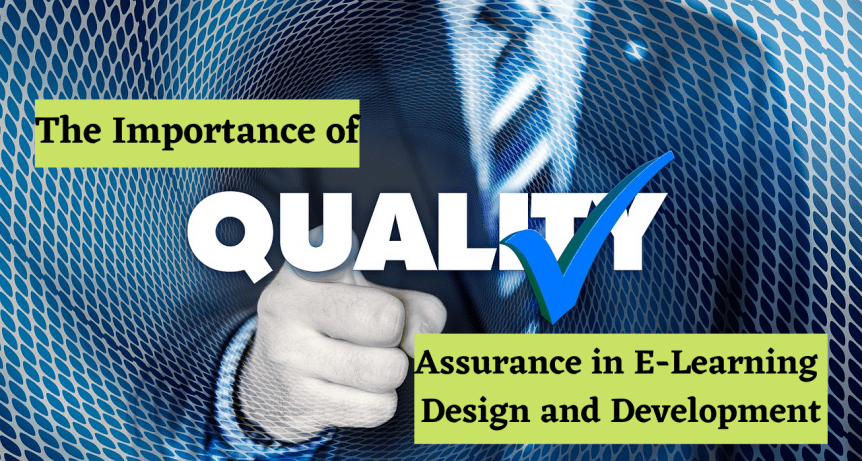There are many different elements that make up the e-learning design and development process. Those elements include gathering content and presenting it within the e-learning course, whether that is in text form, in a video, on an image, or using another type of media. There are also then creative, technical, and UX elements. Errors, bugs, and issues can occur in any of these elements at any time, so quality assurance (QA) should be part of the e-learning design and development process.
Good QA procedures will identify and remove any bugs and errors before the training course is distributed to learners.
Why does this matter, though? After all, are a few spelling mistakes or the occasional grammatical error that big a deal?
Yes, is the short answer, plus the QA process in e-learning design is about much more than checking spelling and grammar. Here are the main reasons why QA is so important when developing a new e-learning course.
Builds Confidence
If a learner encounters errors or mistakes in the e-learning course, they might start second-guessing the quality or accuracy of the information you are presenting them with. This can damage the training and learning outcomes you want to achieve.
On the flip side, by removing issues, errors, and bugs with an effective QA process, the confidence of learners will improve.
It isn’t just learners, either, as it is also important to mention the developer-client relationship. As a client hiring an e-learning developer in the UAE or Saudi Arabia, you need to have confidence that the completed training course you receive is error-free and ready for distribution. A comprehensive QA process gives you this confidence.
Improves Engagement
Following on from some of the points mentioned above, learners are more likely to fully engage with the e-learning course if it works perfectly and is free from mistakes. As engagement is crucial to the learning process, this benefit of e-learning QA shouldn’t be underestimated.
Improves Learner Experience
The QA process improves the experience of learners in a number of ways. This includes removing the annoyance factor that many people experience when they encounter simple and avoidable mistakes, such as spelling errors. Taking it up a level, a spelling mistake or grammatical error could change the meaning of the content, making it even more important for these mistakes to be found and fixed.
An effective QA process will catch problems with the localisation of courses, as well as problems with content flow and how easy it is to understand the content.
There are technical aspects of the QA process that also improve the learner experience. For example, ensuring the e-learning course doesn’t freeze, crash, or do something else otherwise unexpected. QA also catches and resolves navigational issues and problems with crucial elements to the learner experience, such as scenarios and videos.
Ensures Accuracy
The QA process in e-learning includes checking the accuracy and veracity of the content. In other words, does the e-learning course present the right information to learners, and is it factually accurate?
Saves Time
Effective QA processes and procedures can also save time, particularly when the course is being created using an agile development model. With this method of development, QA is an ongoing process that starts in the earliest stages of content generation and concept design and then continues through to completion.
As a result, errors, mistakes, and bugs are picked up and rectified as early as possible, when they are quickest to fix. This particularly applies to technical errors and errors in the code.
Saves Money
The previous section outlines a time saving, but the same points also result in a cost-saving. This is because the cost of fixing errors, mistakes, and bugs increases significantly as the project progresses.
By far the cheapest time to fix a problem is as soon as possible after the problem develops. An effective QA process helps ensure this happens.
Ensures the Launch of Training Courses Goes Smoothly
E-learning training courses that have mistakes, bugs, and errors, particularly technical errors, can cause chaos if they are launched before the problems are rectified. Learners will start asking for help, there might be complaints, and there will be frantic efforts to fix the problems. The course then has to be distributed again, sending you back to square one.
An effective QA process overcomes this issue by ensuring the e-learning training course is bug and error-free before it is sent to learners. This makes the launch much smoother.
Maximises Positive Outcomes
You will have a number of outcomes and objectives that you will want to achieve with your e-learning training course. This can include:
- High completion rates
- Good quiz and test scores
- Positive feedback
- Behavioural change
- Improved productivity, performance, and/or efficiency
- Long-term knowledge retention
An e-learning course that is bug and error-free will help to achieve the above outcomes.
More Effectively Achieve Training Objectives
An effective QA process will also help you achieve your training objectives for the e-learning course, including maximising return on investment.
QA in E-Learning Development – It’s About Much, Much More than Proofreading
Many people think e-learning QA is about proofreading text. This is part of QA, of course, but it is only one part. We’ve highlighted above the main benefits and advantages of QA in e-learning. In future blogs, we’ll look at the potential pitfalls and problems that effective QA overcomes, as well as what is involved in e-learning QA. Here’s a sneak preview – it’s about a lot more than proofreading.
